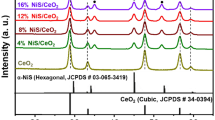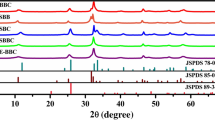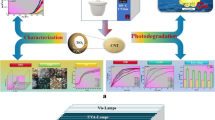Abstract
BiVO4 has been constructed into heterojunctions with TiO2 to boost the photocatalytic ability under visible illumination. Here, mesoporous BiVO4/TiO2 nanocomposites have been fabricated by a facile sol–gel approach utilizing nonionic surfactant and addressed for morphological, optical, structural, and degradation of ciprofloxacin (CIP) in water under visible illumination as an antibiotic pollutant model. The TEM images demonstrated that the TiO2 NPs are homogenous in terms of shape and size (15 ± 5 nm). The introduction of BiVO4 into mesoporous TiO2 could effectively enhance the rapid separation efficiency of the photoinduced carriers and optical absorption. The 3%BiVO4/TiO2 photocatalyst possessed the best degradation efficiency (100%) within 60 min which was promoted 20-folds larger than TiO2 NPs (5%). 3%BiVO4/TiO2 nanocomposite exhibited the fastest degradation rate (2.15 × 10−2 min−1), which was 40 times faster than bare TiO2 photocatalyst (0.05 × 10−2 min−1). The enhanced photocatalytic ability originated from superior charge separation characteristics and high solar energy absorption in mesopore structures. The recombination rate and mobility of charge carriers were characterized utilizing photoluminescence (PL) and photoelectrochemical measurements. This work highlights the advantages of mesoporous heterojunction BiVO4/TiO2 nanocomposites for photocatalytic performances and provides a multilateral route to design an effective wide-spectrum response photocatalyst for the development of comparable materials. The photocatalytic mechanism for degradation CIP over BiVO4/TiO2 was discussed in detail.
.









Similar content being viewed by others
Data availability
Not applicable.
References
Abd-Rabboh HSM, Benaissa M, Hamdy MS, Ahmed MA, Glal M (2021) Synthesis of an efficient, and recyclable mesoporous BiVO4/TiO2 direct Z-scheme heterojunction by sonochemical route for photocatalytic hydrogen production and photodegradation of rhodamine B dye in the visible region. Opt Mater 114:110761
Alamelu K, Raja V, Shiamala L, Jaffar ABM (2018) Biphasic TiO2 nanoparticles decorated graphene nanosheets for visible light driven photocatalytic degradation of organic dyes. Appl Surf Sci 430:145–154
Alshaikh H, Al-Hajji LA, Mahmoud MHH, Ismail AA (2021) Visible-light-driven S-scheme mesoporous Ag3VO4/C3N4 heterojunction with promoted photocatalytic performances. Sep Purif Technol 272:118914
Atitar MF, Ismail AA, Al-Sayari SA, Bahneman D, Afanasev D, Emeline AV (2015) Mesoporous TiO2 nanocrystals as efficient photocatalysts: impact of calcination temperatures and phase transformations on photocatalytic performances. Chem Eng J 264:417–424
Cai ZQ, Zhao X, Wang T, Liu W, Zhao DY (2017) Reusable platinum-deposited anatase/hexa-titanate nanotubes: roles of reduced and oxidized platinum on enhanced solar-light-driven photocatalytic activity. ACS Sustain Chem Eng 5:547–555
Chen C, Cai W, Long M, Zhou B, Wu Y, Wu D, Feng Y (2010) Synthesis of visible-light responsive graphene oxide/TiO2 composites with p/n heterojunction. ACS Nano 4:6425–6432
Chen Y, Gao HY, Xiang JJ, Dong XJ, Cao Y (2018) Enhanced photocatalytic activities of TiO2-reduced graphene oxide nanocomposites controlled by Ti-O-C interfacial chemical bond. Mater Res Bull 99:29–36
Ding Y, Yang IS, Li Z, Xia X, Lee WI, Dai S, Bahnemann DW, Pan JH (2020) Nanoporous TiO2 spheres with tailored textural properties: controllable synthesis, formation mechanism, and photochemical applications. Prog Mater Sci 109:100620
Diugosz M, Zmudzki P, Kwiecien A, Szczubialka K, Krzek J, Nowakowska M (2015) Photocatalytic degradation of sulfamethoxazole in aqueous solution using a floating TiO2-expanded perlite photocatalyst. J Hazard Mater 298:146–153
Elmolla ES, Chaudhuri M (2010) Degradation of amoxicillin, ampicillin and cloxacillin antibiotics in aqueous solution by the UV/ZnO photocatalytic process. J Hazard Mater 173:445–449
Ferrando-Climent L, Rodriguez-Mozaz S, Barceló D (2014) Incidence of anticancer drugs in an aquatic urban system: from hospital effluents through urban wastewater to natural environment. Environ Pollut 193:216–223
Gao B, Sun M, Ding W, Ding Z, Liu W (2021) Decoration of gamma-graphyne on TiO2 nanotube arrays: improved photoelectrochemical and photoelectrocatalytic properties. Appl Catal B-Environ 281:119492
Gregg SJ, Sing KSW (1982) Adsorption, surface area and porosity. Academic Press, London
Guan ZC, Wang HP, Wang X, Hu J, Du RG (2018) Fabrication of heterostructured β-Bi2O3-TiO2 nanotube array composite film for photoelectrochemical cathodic protection applications. Corrosion Sci 136:60–69
He F, Meng A, Cheng B, Ho W, Yu J (2020) Enhanced photocatalytic H2-production activity of WO3/TiO2 step-scheme heterojunction by graphene modification. Chin J Catal 41:9–20
Homem V, Santos L (2011) Degradation and removal methods of antibiotics from aqueous matrices—a review. J Environ Manag 92:2304–2347
Hu Y, Chen W, Fu J, Ba MW, Sun FQ, Zhang P, Zou JY (2018) Hydrothermal synthesis of BiVO4/TiO2 composites and their application for degradation of gaseous benzene under visible light irradiation. Appl Surf Sci 436:319–326
Hughes SR, Kay P, Brown LE (2013) Global synthesis and critical evaluation of pharmaceutical data sets collected from river systems. Environ Sci Technol 47:661–677
Ismail AA (2012) Mesoporous PdO-TiO2 nanocomposites with enhanced photocatalytic activity. Appl Catal B 117–118:67–72
Ismail AA, Ibrahim IA, Mohamed RM (2003) Sol–gel synthesis of vanadia–silica for photocatalytic degradation of cyanide. Appl Catal B 45(2):161–166
Ismail AA, Bahnemann DW, Rathouský J, Yarovyi V, Wark M (2011) Multilayered ordered mesoporous platinum/titania composite films: does the photocatalytic activity benefit from the film thickness? J Mater Chem 21:7802–7810
Ismail AA, Al-Sayari SA, Bahnemann DW (2013) Photodeposition of precious metals onto mesoporous TiO2 nanocrystals with enhanced their photocatalytic activity for methanol oxidation. Catal Today 209:2–7
Kadi MW, McKinney D, Mohamed RM, Mkhalid IA, Sigmund W (2016) Fluorine doped zinc oxide nanowires: enhanced photocatalysts degrade malachite green dye under visible light conditions. Ceram Int 42(4):4672–4678
Kadi MW, Ismail AA, Mohamed RM, Bahnemann DW (2018) Photodegradation of herbicide imazapyr over mesoporous In2O3-TiO2 nanocomposites with enhanced photonic efficiency. Sep Purif Technol 205:66–73
Kadi MW, Mohamed RM, Ismail AA, Bahnemann DW (2020a) Soft and hard templates assisted synthesis mesoporous CuO/g-C3N4 heterostructures for highly enhanced and accelerated Hg (II) photoreduction under visible light. J Colloid Interface Sci 580:223–233
Kadi MW, Mohamed RM, Ismail AA, Bahnemann DW (2020b) Performance of mesoporous α-Fe2O3/g-C3N4 heterojunction for photoreduction of Hg (II) under visible light illumination. Ceram Int 46(14):23098–23106
Kadi MW, Mohamed RM, Ismail AA, Bahnemann DW (2020c) Decoration of g-C3N4 nanosheets by mesoporous CoFe2O4 nanoparticles for promoting visible-light photocatalytic Hg (II) reduction. Colloids Surf A 603:125206
Kim TW, Choi KS (2014) Nanoporous BiVO4 photoanodes with dual-layer oxygen evolution catalysts for solar water splitting. Science 343:990–994
Kim KS, Kam SK, Mok YS (2015) Elucidation of the degradation pathways of sulfonamide antibiotics in a dielectric barrier discharge plasma system. Chem Eng J 271:31–42
Kim H, Yoo K, Kim Y, Yoon SY (2018) Thermochromic behaviors of boron-magnesium co-doped BiVO4 powders prepared by a hydrothermal method. Dye Pigment 149:373–376
Kong D, Liang B, Yun H, Cheng H, Ma J, Cui M, Wang A, Ren N (2015) Cathodic degradation of antibiotics: characterization and pathway analysis. Water Res 72:281–292
Lai YK, Huang JY, Cui ZQ, Ge MZ, Zhang KQ, Chen Z, Chi LF (2016) Recent advances in TiO2-based nanostructured surfaces with controllable wettability and adhesion. Small 12:2203–2224
Liu Z, Xu K, Yu H, Zhang M, Sun Z (2021) In-situ preparation of double Z-scheme Bi2S3/ BiVO4/TiO2 ternary photocatalysts for enhanced photoelectrochemical and photocatalytic performance. Appl Surf Sci 545:148986
Lu Y, Chu Y, Zheng W, Huo M, Huo H, Qu J, Yu H, Zhao Y (2019) Significant tetracycline hydrochloride degradation and electricity generation in a visible-light-driven dual photoelectrode photocatalytic fuel cell using BiVO4/TiO2 NT photoanode and Cu2O/TiO2 NT photocathode. Electrochim Acta 320:134617
Lv YR, Liu CJ, He RK, Li X, Xu YH (2019) BiVO4/TiO2 heterojunction with enhanced photocatalytic activities and photoelectochemistry performances under visible light illumination. Mater Res Bull 117:35–40
Malathi A, Madhavan J, Ashokkumar M, Arunachalam P (2018) A review on BiVO4 photocatalyst: activity enhancement methods for solar photocatalytic applications. Appl Catal A Gen 555:47–74
Mehta M, Krishnamurth S, Basu S, Nixon TP, Singh AP (2020) BiVO4/TiO2 core-shell heterostructure: wide range optical absorption and enhanced photoelectrochemical and photocatalytic performance. Mater Today Chem 17:100283
Meng X, Zhang Z (2016) Bismuth-based photocatalytic semiconductors: introduction, challenges and possible approaches. J Mol Catal A Chem 423:533–549
Mkhalid IA, Mohamed RM, Alhaddad M, Basaleh A, Al-Hajji LA, Ismail AA (2022) S-Scheme mesoporous Li2MnO3/g-C3N4 heterojunctions as efficient photocatalyst for mineralization of trichloroethylene in aqueous media. J Colloid Interfaces Sci 614:160–171
Mohamed RM, Ismail AA (2021) Photocatalytic reduction and removal of mercury ions over mesoporous CuO/ZnO S-scheme heterojunction photocatalyst. Ceram Int 47:9659–9667
Mohamed RM, Shawky A (2018) CNT supported Mn-doped ZnO nanoparticles: simple synthesis and improved photocatalytic activity for degradation of malachite green dye under visible light. Appl Nanosci 8(5):1179–1188
Mohamed RM, Harraz FA, Mkhalid IA (2012) Hydrothermal synthesis of size-controllable Yttrium Orthovanadate (YVO4) nanoparticles and its application in photocatalytic degradation of direct blue dye. J Alloy Compd 532:55–60
Mohamed RM, McKinney D, Kadi MW, Mkhalid IA, Sigmund W (2016) Platinum/zinc oxide nanoparticles: enhanced photocatalysts degrade malachite green dye under visible light conditions. Ceram Int 42(8):9375–9381
Mohamed RM, Ismail AA, Kadi MW, Bahnemann DW (2018) A comparative study on mesoporous and commercial TiO2 photocatalysts for photodegradation of organic pollutants. J Photochem Photobiol A 367:66–73
Mohamed RM, Mkhalid IA, Alhaddad M, Basaleh A, Alzahrani KA, Ismail AA (2021) Enhanced CO2 photocatalytic conversion into CH3OH over visible-light-driven Pt nanoparticle-decorated mesoporous ZnO–ZnS S-scheme heterostructures. Ceram Int 47:26779–26788
Osmando FL, KeleAndré KTGEN, Waldir AJ, Caue R (2016) Controlled synthesis of BiVO4 photocatalysts: evidence of the role of heterojunctions in their catalytic performance driven by visible-light. Appl Catal B Environ 188:87–97
Pawar RC, Lee CS (2014) Single-step sensitization of reduced graphene oxide sheets and CdS nanoparticles on ZnO nanorods as visible-light photocatalysts. Appl Catal B Environ 144:57–65
Shawky A, Alhaddad M, Al-Namshah KS, Mohamed RM, Awwad NS (2020) Synthesis of Pt-decorated CaTiO3 nanocrystals for efficient photoconversion of nitrobenzene to aniline under visible light. J Mol Liq 304:112704
Sadeghzadeh-Attar A (2020) Boosting the photocatalytic ability of hybrid BiVO4-TiO2 heterostructure nanocomposites for H2 production by reduced graphene oxide (rGO). J Taiwan Inst Chem Eng 111:325–336
Samsudin MFR, Sufian S, Mohamed NM, Bashiri R, Wolfe F, Ramli RM (2018) Enhancement of hydrogen production over screen-printed TiO2/ BiVO4 thin film in the photoelectrochemical cells. Mater Lett 211:13–16
Stefan M, Pana O, Leostean C, Bele C, Silipas D, Senila M, Gautron E (2014) Synthesis and characterization of Fe3O4-TiO2 core-shell nanoparticles. J Appl Phys 116:1902
Wang X, Sø L, Su R, Wendt S, Hald P, Mamakhel A, Yang C, Huang Y, Iversen BB, Besenbacher F (2014) The influence of crystallite size and crystallinity of anatase nanoparticles on the photo-degradation of phenol. J Catal 310:100–108
Wang X, Guan Z, Jin P, Tang Y, Song G, Liu G, Du R (2019) Facile fabrication of BiVO4 modified TiO2 nanotube film photoanode and its photocathodic protection effect on stainless steel. Corrosion Sci 157:247–255
Wu Z, Yuan X, Zeng G, Jiang L, Zhong H, Xie Y, Wang H, Chen X, Wang H (2018) Highly efficient photocatalytic activity and mechanism of Yb3+/Tm3+ codoped In2S3 from ultraviolet to near infrared light towards chromium (VI) reduction and rhodamine B oxydative degradation. Appl Catal B 225:8–21
Zalfani M, Hu ZY, Yu WB, Mahouani M, Bourguiga R, Li MWY, Tendeloo GV, Djaoued Y, Su BL (2017) BiVO4/3DOM TiO2 nanocomposites: effect of BiVO4 as highly efficient visible light sensitizer for highly improved visible light photocatalytic activity in the degradation of dye pollutants. Appl Catal B Environ 205:121–132
Zhu M, Sun Z, Fujitsuka M, Majima T (2018) Z-scheme photocatalytic water splitting on a 2D heterostructure of black phosphorus/bismuth vanadate using visible light. Angew Chem Int Edit 57:2160–2164
Funding
This project was funded by the Deanship of Scientific Research (DSR) at King Abdulaziz University, Jeddah, Saudi Arabia, under grant no. KEP-29–130-42. The authors, therefore, acknowledge with thanks DSR for technical and financial support.
Author information
Authors and Affiliations
Contributions
N.Y.T.: conceptualization, project administration, writing—original draft, funding acquisition. S.M.A.: investigation, methodology, formal analysis. A.A.I.: data curation, writing—review and editing, supervision.
Corresponding author
Ethics declarations
Ethics approval
Not applicable.
Consent to participate
Not applicable.
Consent for publication
Not applicable.
Conflict of interest
The authors declare no competing interests.
Additional information
Responsible editor: Sami Rtimi
Publisher's note
Springer Nature remains neutral with regard to jurisdictional claims in published maps and institutional affiliations.
Rights and permissions
About this article
Cite this article
Tashkandi, N.Y., Albukhari, S.M. & Ismail, A.A. Mesoporous BiVO4/TiO2 heterojunction: enhanced photoabsorption and photocatalytic ability through promoted charge transfer. Environ Sci Pollut Res 29, 78472–78482 (2022). https://doi.org/10.1007/s11356-022-21336-1
Received:
Accepted:
Published:
Issue Date:
DOI: https://doi.org/10.1007/s11356-022-21336-1




